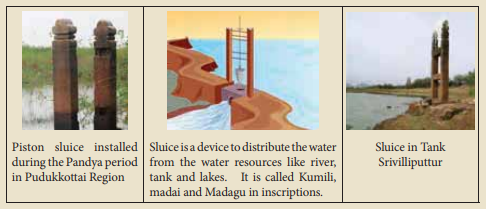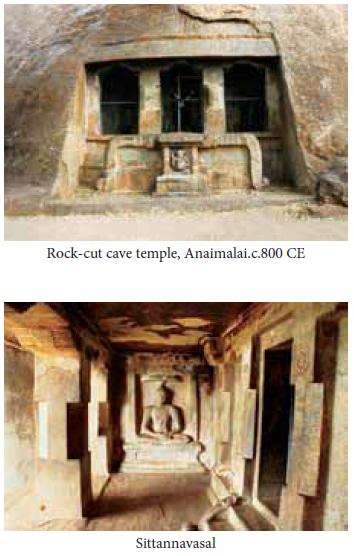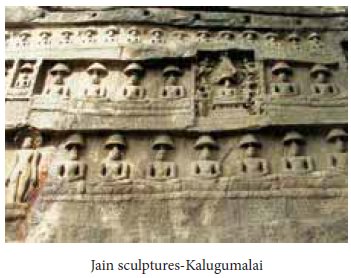History - Pandyas | 11th History : Chapter 11 : Later Cholas and Pandyas
Chapter: 11th History : Chapter 11 : Later Cholas and Pandyas
Pandyas
PANDYAS
Pandyas were one of the muvendars that ruled the southern part of India, though intermittently, until the pre-modern times. Ashoka, in his inscriptions, refers to Cholas, Cheras, Pandyas and Satyaputras as peoples of South India. Korkai, a town historically associated with pearl fisheries, is believed to have been their early capital and port. They moved to Madurai later.
Many early Tamil inscriptions of Pandyas have been found in Madurai and its surroundings. Madurai is mentioned as Matirai in these Tamil inscriptions, whereas Tamil classics refer to the city as Kudal, which means assemblage. In one of the recently discovered Tamil inscriptions from Puliman Kompai, a village in Pandya territory, Kudal is mentioned. In Pattinappalai and Maduraikkanchi, Koodal is mentioned as the capital city of Pandyas. It finds mention in Ettuthogai (Eight Anthologies) also. So, historically Madurai and Kudal have been concurrently used.
Sources
The history of the Pandyas of the Sangam period, circa third century BCE to third century CE, has been reconstructed from various sources such as megalithic burials, inscriptions in Tamil brahmi, and the Tamil poems of the Sangam literature. The Pandyas established their supremacy in South Tamil Nadu by the end of the sixth century CE. A few copper plates form the source of our definite knowledge of the Pandyas from the seventh to the ninth century. The Velvikkudi grant of Nedunjadayan is the most important among them. Copper plates inform the essence of royal orders, genealogical list of the kings, their victory over the enemies, endowments and donations they made to the temples and the Brahmins. Rock inscriptions give information about the authors of rock-cut cave temples, irrigation tanks and canals. Accounts of travellers such as Marco Polo, Wassaff and Ibn-Batuta are useful to know about political and socio-cultural developments of this period. Madurai Tala Varalaru, Pandik Kovai and Madurai Tiruppanimalai provide information about the Pandyas of Madurai of later period.
Though pre-Pallavan literary works do not speak of Sangam as an academy, the term Sangam occurs in Iraiyanar Akapporul of late seventh or eighth century CE. The term Sangam, which means an academy, is used in late medieval literary works like Periya Puranam and Tiruvilaiyadal Puranam.
Territory
The territory of Pandyas is called Pandymandalam, Thenmandalam or Pandynadu, which lay in the rocky, hilly regions and mountain ranges except the areas fed by the rivers Vaigai and Tamiraparni. River Vellar running across Pudukkottai region had been demarcated as the northern border of the Pandya country, while Indian Ocean was its southern border. The Western Ghats remained the border of the west while the Bay of Bengal formed the eastern border.
1. Pandya Revival (600–920)
The revival of the Pandyas seems to have taken place after the disappearance of the Kalabhras. Once hill tribes, the Kalabhrashad soon taken to a settled life, extending their patronage to Buddhists and Jains. Kadunkon, who recovered Pandya territory from the Kalabhras according to copper plates, was succeeded by two others. Of them, Sendan possessed warlike qualities and his title Vanavan is suggestive of his conquest of Cheras. The next one, Arikesari Maravarman (624–674), an illustrious early Pandya, ascended the throne in 642, according to a Vaigai river bed inscription. He was a contemporary of Mahendravarman I and Narsimahvarman I. Inscriptions and copper plates praise his victory over his counterparts such as Cheras, Cholas, Pallavas and Sinhalese. Arikesari is identified with Kun Pandian, the persecutor of Jains.

Cheras. He expanded the Pandya territory into Thanjavur, Tiruchirappalli, Salem and Coimbatore districts. He is also credited with building several Siva and Vishnu temples. The next king Srimara Srivallabha (815–862) invaded Ceylon and maintained his authority. However, he was subsequently defeated by Pallava Nandivarman III (846–869). He was followed by Varaguna II who was defeated by Aparajita Pallava (885–903) at Sripurmbiyam. His successors, Parantaka Viranarayana and Rajasimha II, could not stand up to the rising Chola dynasty under Parantaka I. Parantaka I defeated the Pandya king Rajasimha II who fled the country in 920CE.
Rise of Pandyas Again (1190–1310)
In the wake of the vacuum in Chola state in the last quarter of 12th century after the demise of Adhi Rajendra, Chola viceroyalty became weak in the Pandya country. Taking advantage of this development, Pandya chieftains tried to assert and rule independently. Sri Vallaba Pandyan fought Rajaraja II and lost his son in the battle. Using this situation, the five Pandyas waged a war against Kulotunga I (1070–1120) and were defeated. In 1190, Sadayavarman Srivallabhan, at the behest of Kulotunga I, started ruling the Pandya territory. He was anointed in Madurai with sceptre and throne. To commemorate his coronation, he converted a peasant settlement Sundaracholapuram as Sundarachola Chaturvedimangalam, a tax-exempted village for Brahmins.
After the decline of the Cholas, Pandya kingdom became the leading Tamil dynasty in the thirteenth century. Madurai was their capital. Kayal was their great port. Marco Polo, the famous traveller from Venice, visited Kayal twice, in 1288 and in 1293. He tells us that this port town was full of ships from Arabia and China and bustling with business activities.
Sadaiyavarman Sundarapandyan
The illustrious ruler of the second Pandya kingdom was Sadaiyavarman (Jatavarman) Sundarapandyan (1251– 1268), who not only brought the entire Tamil Nadu under his rule, but also exercised his authority up to Nellore in Andhra. Under his reign, the Pandya state reached its zenith, keeping the Hoysalas in check. Under many of his inscriptions, he is eulogized. Sundarapandyan conquered the Chera ruler, the chief of Malanadu, and extracted a tribute from him. The decline of the Chola state emboldened the Boja king of Malwa region Vira Someshwara to challenge Sundarapandyan, who in a war at Kannanur defeated him. Sundarapandian plundered his territory. He put Sendamangalam under siege. After defeating the Kadava chief, who ruled from Cuddalore and wielded power in northern Tamil Nadu, Sundarapandyan demanded tribute. He captured the western region and the area that lay between present-day Arcot and Salem. After killing the king of Kanchipuram in a battle, Pandyas took his territory. But, by submitting to the Pandyas, the brother of the slain king got back Kanchipuram and agreed to pay tribute. Along with him, there were two or three co-regents who ruled simultaneously: Vikrama Pandyan and Vira Pandyan. A record of Vira Pandyan (1253–1256) states that he took Eelam (Ceylon), Kongu and the Cholamandalam (Chola country).
Maravarman Kulasekharan
After Sundarapandyan, Maravarman Kulasekharan ruled successfully for a period of 40 years, giving the country peace and prosperity. We have authentic records about the last phase of his reign. He ascended the throne in 1268 and ruled till 1312. He had two sons, and in 1302, the accession of the elder son, Jatavarman Sundara Pandyan III, as co-regent took place. The king’s appointment of Sundarapandyan as a co-regent provoked the other son Vira Pandyan and so he killed his father Maravarman Kulasekharan. In the civil war that ensued, Vira Pandyan won and became firmly established in his kingdom. The other son, Sundara Pandyan, fled to Delhi and took refuge under the protection of Alauddin Khalji. This turn of events provided an opening for the invasion of Malik Kafur.
Invasion of Malik Kafur
When Malik Kafur arrived in Madurai in 1311, he found the city empty and Vira Pandyan had already fled. In Amir Khusru’s estimate, 512 elephants, 5,000 horses along with 500 mounds of jewel of diamonds, pearls, emeralds and rubies are said to have been taken by Malik Kafur. The Madurai temple was desecrated and an enormous amount of wealth was looted. The wealth he carried was later used in Delhi by Alauddin Khalji, who had then taken over the throne, to wean away the notables in the court to his side against other claimants.
After Malik Kafur’s invasion, the Pandyan kingdom came to be divided among a number of the main rulers in the Pandya’s family. In Madurai, a Muslim state subordinate to the Delhi Sultan came to be established and continued until 1335 CE when the Muslim Governor of Madurai Jalaluddin Asan Shah threw off his allegiance and declared himself independent.
2. State
Pandya kings preferred Madurai as their capital. Madurai has been popularly venerated as Kudal and Tamil Kelukudal. The kings are traditionally revered as Kudalkon, Kudal Nagar Kavalan, Madurapura Paramesvaran. The titles of the early Pandyas are: Pandiyatirasan, Pandiya Maharasan, Mannar Mannan, Avaniba Sekaran, Eka Viran, Sakalapuvana Chakkaravarti and others. Titles of the later Pandyas in Sanskrit include Kodanda Raman, Kolakalan, Puvanekaviran, and Kaliyuga Raman. Titles in chaste Tamil are Sembian, Vanavan, Thennavan and others. The Pandyas derived military advantage over their neighbours by means of their horses, which they imported through their connection to a wider Arab commercial and cultural world.
Palace and Couch
Royal palaces were called Tirumaligai and Manaparanan Tirumaligai. Kings, seated on a royal couch, exercised the power. The naming of couches after the local chiefs attests to the legitimacy of overlordship of the kings. The prominent names of such couches are Munaiya Daraiyan, Pandiya Daraiyan and Kalinkat Traiyan.
The king issued royal order orally while majestically seated on the couches. It was documented by royal scribe called Tirumantira Olai.
Royal Officials
A band of officials executed the royal orders. The prime minister was called uttaramantri. The historical personalities like Manickavasagar, Kulaciraiyar and Marankari worked as ministers. The royal secretariat was known as Eluttu Mandapam. Akapparivara Mudalikal were the personal attendants of the kings. The most respected officials were Maran Eyinan, Sattan Ganapathy, Enathi Sattan, Tira Tiran, Murthi Eyinan and others. The titles of military commanders were Palli Velan, Parantakan Pallivelan, Maran Adittan and Tennavan Tamizhavel.
Political Divisions
Pandy Mandalam or Pandy Nadu consisted of many valanadus, which, in turn, were divided into many nadus and kurrams. The administrative authorities of nadus were the nattars. Nadu and kurram contained settlements, viz., mangalam, nagaram, ur and kudi, which were inhabited by different social groups. A unique political division in Pandy Mandalam is Kulakkil, i.e. area under irrigation tank. For instance, Madurai is described in an inscription as Madakkulakkil Madurai.
The duty of the nattar was to assess the qualities of land under cultivation and levy taxes. In surveying the lands, the officials used rods of 14 and 24 feet. After the measurement, the authorities donated the lands. Salabogam land was assigned to Brahmins. The land assigned to ironsmiths was called tattarkani; for carpenters, it was known as taccu-maniyam. Bhattavriutti is the land donated for Brahmin group for imparting education.
Administration and Religion: Seventh to Ninth Centuries
An inscription from Manur (Tirunelveli district), dating to 800, provides an account of village administration. It looks similar to Chola’s local governance, which included village assemblies and committees. Both civil and military powers were vested in the same person. The Pandya kings of the period supported and promoted Tamil and Sanskrit. The great Saiva and Vaishnava saints contributed to the growth of Tamil literature. The period was marked by intense religious tussles. The rise of the Bhakti movement invited heterodox scholars for debate. Many instances of the defeat of Buddhism and Jainism in such debates are mentioned in Bhakti literature.
3. Economy
Society
Kings and local chiefs created Brahmin settlements called Mangalam or Chaturvedimangalam with irrigation facilities. These settlements were given royal names and names of the deities. Influential Brahmins had honorific titles such as Brahmmadhi Rajan and Brahmmaraiyan.
Trade
It was not the Khalji’s invasion from the north that brought the Muslims into Tamil country for the first time. Arab settlements on the west coast of southern India, from the seventh century, led to the expansion of their trade connection to the east coast of Tamizh country. This was because the governments of the east coast pursued a more liberal and enlightened policy towards the overseas traders. Their charters exempted traders from various kinds of port dues and tolls. In Kayal, there was an agency established by an Arab chieftain by name Maliku-l-Islam Jamaluddin. This agency facilitated the availability of horses to Pandya kings.
In the inscriptions, the traders are referred to as nikamattor, nanadesi, ticai-ayiratu-ainutruvar, ainutruvar, manikiramattar and patinen-vishyattar. They founded the trade guilds in Kodumpalur and Periyakulam. The goods traded were spices, pearls, precious stones, horses, elephants and birds. In the thirteenth and fourteenth centuries, horse trade was brisk. Marco Polo and Wassaff state that the kings invested in horses as there was a need of horses for ceremonial purposes and for fighting wars. Those who were trading in horses were called kudirai-chetti. They were active in maritime trade also.
The busiest port town under the Pandyas was Kayalpattinam (now in Thoothukudi district) on the east coast. Gold coins were in circulation as the trade was carried through the medium of gold. It was variously called kasu, palankasu, anradunarpalankasu, kanam, kalancu and pon. The titular gods of the traders are Ayirattu Aynurruvaar Udaiyar and Sokka Nayaki Amman. The periodically held fairs were called Tavalamin settlements called teru where the traders lived.
Irrigation
The Pandya rulers created a number of irrigation sources and they were named after the members of the royal family. Some of them were Vasudeva Peraru, Virapandya Peraru, Srivallaba Peraru and Parakirama Pandya Peraru. The tanks were named Tirumaleri, Maraneri, Kaliyaneri and Kadaneri. On either side of the rivers Vaigai and Tamiraparni, canals leading to the tanks for irrigation were built. The Sendan Maran inscription of Vaigai river bed speaks of a sluice installed by him to distribute the water from the river. Sri Maran Srivallabhan created a big tank, which is till now in use. Like Pallavas in northern districts, Pandyas introduced the irrigation technology in the southern districts of Tamil country. In building the banks of the tanks, the ancient architect used the thread to maintain the level. Revetment of the inner side of the banks with stone slabs is one of the features of irrigation technique in Pandya country. In the time of the later Pandyas (around 1212), an official constructed a canal leading from river Pennai to the lands of Tiruvannamalai temple. In dry-zone Ramanathupuram also, tanks were created. In these areas, such irrigation works were done by local administrative bodies, local chiefs and officials. Repairs were mostly undertaken by local bodies. Sometimes, traders also dug out tanks for irrigation.
Iruppaikkuti-kilavan, a local chief, built many tanks and repaired the tanks in disrepair. The actual landowning groups are described as the Pumipittirar. Historically they were locals and hence they were referred to as nattumakkal. The communal assembly of this group is Cittirameli-periyanattar.
Literacy
The mission of promoting literacy was carried on through many ways. Appointment of singers to recite the Bhakti hymns in temple has been seen as the attempt of promoting literacy. In theatres, plays were staged for a similar purpose. Bhattavirutti and salabogam were endowments provided for promoting Sanskrit education.

Brahmins studied the Sanskrit treatises in educational centres kadigai, salai and vidyastanam. From 12th century, monasteries came up and they were attached to the temples to promote education with religious thrust. A copper inscription says that an academy was set up to promote Tamil and to translate Mahabharatam. The important Tamil literary texts composed in the reign of the Pandyas were Tiruppavai, Tirvempavai, Tiruvasagam, Tirukkovai and Tirumantiram.
4. Religion
It is said that Pandyas were Jains initially and later adopted Saivism. Inscriptions and the sculptures in the temples attest to this belief. The early rock-cut cave temples were the outcrop of transitional stage in religion and architecture. Medieval Pandyas and later Pandyas repaired many temples and endowed them with gold and land. The vimanam over the sanctum of Srirangam and Chidambaram temples were covered with golden leaves. Sadaiyavarman Sundarapandyan was anointed in Srirangam temple, and to commemorate it, he donated an idol of Vishnu to the temple. The inner walls of this temple and three other gopurams were plated with gold.
Pandyas extended patronage to Vedic practices. Palyagasalai Mudukudumi Peruvaluthi, who performed many Vedic rituals, is identified with Pandyas of the Sangam period. Velvikkudi copper plates as well as inscriptional sources mention the rituals like Ashvamedayaga, Hiranyagarbha and Vajapeya yagna, conducted by every great Pandya king. The impartiality of rulers towards both Saivism and Vaishnavism is also made known in the invocatory portions of the inscriptions. Some kings were ardent Saivite; some were ardent Vaishnvavites. Temples of both sects were patronised through land grant, tax exemption, renovation and addition of gopuras and spacious mandapas.
Temples
Pandyas built different models of temples. They are sepulchral temple (e.g sundarapandisvaram), rock-cut cave temples and structural temples. Medieval Pandyas and later Pandyas did not build any new temples but maintained the existing temples, enlarging them with the addition of gopuras, mandapas and circumbulations.

The monolithic mega-sized ornamented pillars are the unique feature of the medieval Pandya style. The early Pandya temples are modest and simple. In these temples of the Pandya country, the sculptures of Siva, Vishnu, Kotravai, Ganesa, Subramanya, Surya and Brahma are best specimens. Pandyas specially patronised Meenakshi temple and kept expanding its premises by adding gopuras and mandapas.
The prominent rock-cut cave temples created by the early Pandyas are found in Pillayarpatti, Tirumeyyam, Kuntrakkudi, Tiruchendur, Kalugumalai, Kanyakumari and Sittannavasal. Paintings are found in the temples in Sittannavasal, Arittaapatti, Tirumalaipuram and Tirunedunkarai.

A 9th century inscription from Sittannavasal cave temple informs that the cave was authored by Ilam Kautamar. Another inscription of the same period tells us that Sri Maran Srivallaban renovated this temple. The fresco paintings on the walls, ceilings and pillars are great works of art. These paintings portray the figures of dancing girls, the king and the queen. The painting of water pool depicts some aquatic creatures, flowers and birds and some mammals.
The maritime history of India would be incomplete if the history of the Pandyas of Tamil country is skipped. The busiest port-towns were located all along the east coast of the Tamizh country. By establishing matrimonial link with Southeast Asian dynasties, Pandyas left an imprint in maritime trade activities.
Related Topics